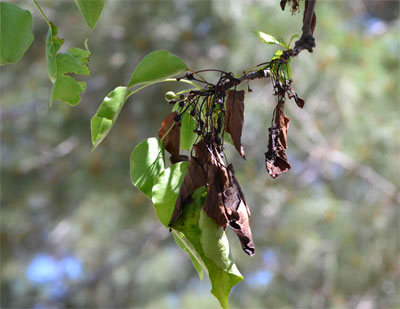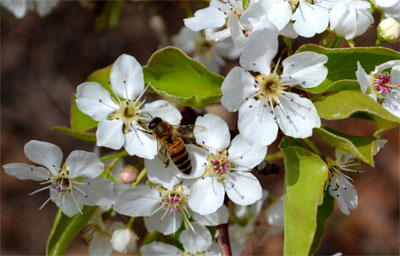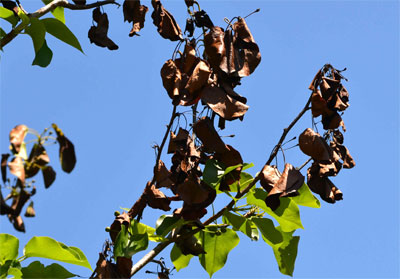Texas Tree Tips – April, 2012

The scorched appearance of leaves, fruit, and stems on flowering pears is symptomatic of fire blight. All photos courtesy of Bill Seaman.
Fire Blight Epidemic Blackens Flowering Pears
Are you noticing that your flowering pear trees have struggled a bit this spring? While March left them loaded with white blossoms and glossy green foliage, April has not been so kind. The trees’ flowers are now skeletal-like remains, scorched and hanging as if epoxyed to equally blackened stems. The trees’ canopies are a checkerboard of green and black. That ‘Aristocrat’ doesn’t look very noble. Such is fire blight.
A bacterial disease of apples, pears, and other members of the Rosaceae family, fire blight has long been a challenge for serious gardeners. If this is news to you, there should be comfort in knowing that you are not alone. For decades, plant breeders have been making tree selections with a greater resistance to fire blight. Their research first focused on agricultural products, but eventually bled over into ornamental horticulture. As resistant trees became available at nurseries and garden centers, susceptible varieties faded away. Likewise, as newly planted trees flourished in the landscape, the old cultivars declined, died, and were removed. With a wide selection of highly resistant trees, fire blight became a thing of the past — almost.
This spring’s warm temperatures, abundant rain, and high humidity created an incubator for the fire blight bacterium, Erwinia amylovora. The microorganism began its reproductive ooze cycle just as flowering pears were most susceptible — when flower buds opened and new leaves unfurled. It has been 10 years since occurrences of this plant disease have been this numerous.

Honeybees and other pollinating insects inadvertently transport the fire blight bacteria from infected trees to healthy trees, spreading the disease.
For fire blight to spread from one tree to another, it needs transportation. Honeybees and other insects do that job. As they move from flower to flower, insects become pollinators and bacterial ooze inoculators. Transported bacteria multiply in the flower nectar and enter the flower tissue. From the flower, the bacteria move into the stems and destroy the vascular system. The resulting girdled branch dies along with its leaves, flowers, and fruit.

Fire blight bacteria quickly destroy the vascular tissue of succulent growth, girdling infected stems.
Managing fire blight is a challenge because the pathogen can spread throughout the same tree during consecutive years. Raindrops can splash bacterial-rich ooze to the natural openings in leaves and stems, causing new infections. Contaminated pruning tools can also spread fire blight.
Since there is no cure for fire blight, prevention is the best management practice. The No. 1 method of prevention is to plant disease-resistant varieties. If you planted ‘Aristocrat’, ‘Bradford’, ‘Capital’, ‘Whitehouse’, or any number of the resistant named cultivars, you complied with the first method of prevention — even if your selection was inadvertent. Method No. 2 is to prune out all the infected stems. In cases where the infections are isolated, pruning might be practical. However, addressing this year’s outbreak might require hundreds of pruning cuts per tree and gallons of bleach, since pruning tools should be disinfected between cuts. At best, the pruning result would probably look like a dog with a bad haircut.
That leaves method No. 3 — chemical sprays. Agrimycin continues to be the most effective chemical management tool. It is applied to prevent the infection of healthy trees when they are vulnerable to fire blight. Agrimycin can also be applied to infected trees to reduce the probability that the previous year’s infections will spread. In general, spray applications begin in the spring as the first flower buds open; and they are repeated seven to 10 days later. Some years may require a third spray application. Gardeners who are up to the task should follow the specific spray application directions found on the agrimycin product container. By the way — remember the honeybees and the “beneficial” insects that gifted your trees with fire blight? Agrimycin will not harm them. They may even enjoy the cleansing shower.
It is unlikely that this year’s epidemic of fire blight will result in the immediate demise of your flowering pears. In fact, while the bacteria are dormant, it is unlikely that new symptoms will appear before next spring. To compensate for the damage and to improve the tree’s general health, a light application of a slow-release nitrogen fertilizer is in order. Avoid applying high amounts of nitrogen that may generate excessive succulent foliage — the very thing fire blight prefers.
If your flowering pears or other fire blight-susceptible trees are symptomatic, place a reminder on your gardening To-Do list to implement an agrimycin spray program next year. While there is no way to know what next spring’s weather conditions may be, we can prepare for the worst, but maintain the optimism that makes us good gardeners.
About the author: Steve Houser is a Dallas native with more than 30 years of experience as a consulting arborist and tree climber. He is the president of Arborilogical Services Inc., “The Experts Your Trees Deserve.” www.arborilogical.com.

